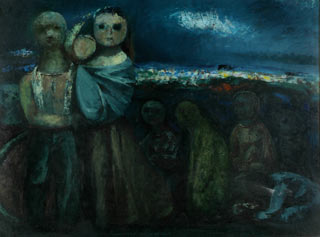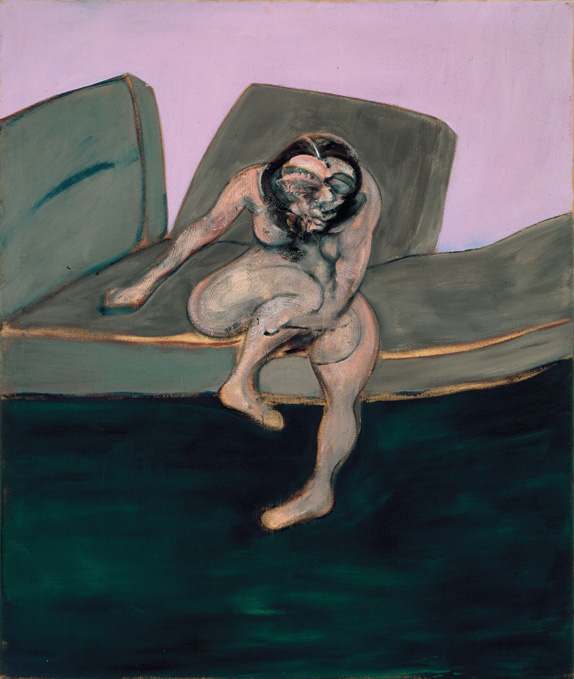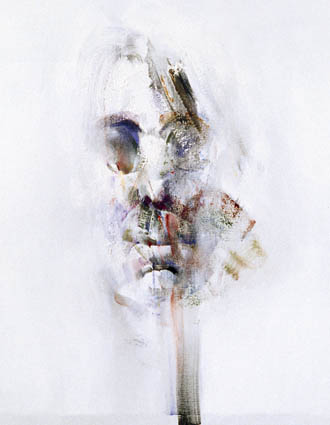New exhibition offers healing for our wounds

It's a misconception that for the first two thirds of the 20th century Ireland existed in a kind of self-contained cultural bubble, safely removed from the artistic developments unfolding at a dizzying rate elsewhere. We are led to believe that the only Irish people to make strides in the worlds of literature, painting, sculpture and design were those who went to live on the Continent while native Irish art remained traditional, insular and stilted. If The Moderns, the mammoth new exhibition at the Irish Museum of Modern Art (IMMA), demonstrates anything it is the facileness of this view. It proves that far from being 'visual illiterates' fearful of the new and the different, our native artists were producing brilliantly original work just as innovative as any produced in other countries.
 The Moderns brings together 250 works by 180 creative figures produced between the years 1900 and 1975. Not only is it one of the largest shows ever mounted at IMMA, it is also an interdisciplinary one, taking in the work of artists, writers, filmmakers, photographers, architects, designers and composers. What makes this exhibition even more special is that spectators have the opportunity to see how these Irish works compare with those of European figures who were active in the same areas at the same time. All of these pieces have come from IMMA's own holdings, loans from prestigious museums and galleries and from the collections of generous private individuals. Altogether it amounts to a tremendous survey of the Irish imagination as it responded to the unprecedented change of these years.
The Moderns brings together 250 works by 180 creative figures produced between the years 1900 and 1975. Not only is it one of the largest shows ever mounted at IMMA, it is also an interdisciplinary one, taking in the work of artists, writers, filmmakers, photographers, architects, designers and composers. What makes this exhibition even more special is that spectators have the opportunity to see how these Irish works compare with those of European figures who were active in the same areas at the same time. All of these pieces have come from IMMA's own holdings, loans from prestigious museums and galleries and from the collections of generous private individuals. Altogether it amounts to a tremendous survey of the Irish imagination as it responded to the unprecedented change of these years.
('Family' by Dan O'Neill c. 1970)
Academics have divided up 20th century art into movements, phases and schools but often these distinctions don't hold together. This is because they are unable to take into account the idiosyncrasies of the individual artist, those indefinable aspects of their talent that distinguish them from all others. Faced with this problem this exhibition might have been chaotic. However, The Moderns is so well curated that you don't have to be an art critic to understand what you're looking at. Simply worded reference points give you a concise profile of each artist and allows you to see how the specific exhibit represents their overall oeuvre.
 The best way to assess this formidable collection is to go with your instincts. If a work doesn't appeal go and look at something that does and when you return to it you can discover that your original perception has changed. Admirers of the great Jack B. Yeats are certainly spoilt for choice in the first section. Twenty major pictures spanning his long and prolific career reveal how the gentle stylization of Yeats' early years gave way to the vivid impressionism, riots of wild colour carried off with supreme élan, of his latter days. Next are four tremendous figure studies by Maime Jellett, a match for any of her European counterparts. One of Ireland's earliest Cubists, Jellet and her fellow artist Evie Hone organised the first exhibition of abstract art in this country in 1923 when she was only 26 and continued to produce radical work until her death in 1944.
The best way to assess this formidable collection is to go with your instincts. If a work doesn't appeal go and look at something that does and when you return to it you can discover that your original perception has changed. Admirers of the great Jack B. Yeats are certainly spoilt for choice in the first section. Twenty major pictures spanning his long and prolific career reveal how the gentle stylization of Yeats' early years gave way to the vivid impressionism, riots of wild colour carried off with supreme élan, of his latter days. Next are four tremendous figure studies by Maime Jellett, a match for any of her European counterparts. One of Ireland's earliest Cubists, Jellet and her fellow artist Evie Hone organised the first exhibition of abstract art in this country in 1923 when she was only 26 and continued to produce radical work until her death in 1944.
('Seek No Further II' by Jack B. Yeats c. 1940)
From here on we are treated to a glorious selection of the finest works by all the major names of the 40's, 50's and 60's, including Paul Henry, Sean Keating, Maurice MacGonigal, Daniel O'Neill and Edward McGuire. It's refreshing to see the quality on display here. The sophisticated Surrealist Colin Middleton is given as much space as the popular painter of everyday Dublin life Harry Kernoff. It's also interesting to see some of the links that are made. Patrick Swift is juxtaposed with Lucian Freud, a parallel is struck between Neville Johnson and Giorgio de Chirico, while a magnificent Henry Moore reclining figure sits alongside a beautiful stone carving by his contemporary, the Banbridge-born F.E. McWilliam. By the time you arrive in a room containing monumental works by Louis LeBrocquy and Francis Bacon the whole experience becomes overpowering.
 Like all of the most memorable exhibitions The Moderns has plenty of surprises. The MacGonigal looks more like a Keating than the Keating does, there is a figurative oil by William Scott which could easily be an early LeBrocquy and you need to stand on the other side of the room from a small George Campbell before its abstraction resolves into an image of the artist's apartment. It's also intriguing to see how the lesser-known artists often get the better of their much more famous colleagues. The haunting still lives of Patrick Hennessy are some of the exhibition's most arresting paintings while Hilary Heron's Torso is a captivating piece of sculpture. Some of the most impressive artistry is to be seen in architectural plans, while Eileen Gray's ingeniously suave furniture designs look far too modern to be a product of the 1920's. What's more, the careful mingling of the different disciplines means that you are constantly presented with something new.
Like all of the most memorable exhibitions The Moderns has plenty of surprises. The MacGonigal looks more like a Keating than the Keating does, there is a figurative oil by William Scott which could easily be an early LeBrocquy and you need to stand on the other side of the room from a small George Campbell before its abstraction resolves into an image of the artist's apartment. It's also intriguing to see how the lesser-known artists often get the better of their much more famous colleagues. The haunting still lives of Patrick Hennessy are some of the exhibition's most arresting paintings while Hilary Heron's Torso is a captivating piece of sculpture. Some of the most impressive artistry is to be seen in architectural plans, while Eileen Gray's ingeniously suave furniture designs look far too modern to be a product of the 1920's. What's more, the careful mingling of the different disciplines means that you are constantly presented with something new.
('Seated Woman (Portrait of Muriel Belcher)' by Francis Bacon, 1961)
 No brief summary can do justice to this fantastic exhibition. There is such a vast array of material that this is an exhibition that demands to be seen more than once. As the Minister for the Arts recently said The Moderns is "an absorbing journey through Ireland's rich and diverse cultural life which reminds us that Ireland's vibrant 21st century arts sector is built on a rich and distinguished cultural heritage to which all of us, as Irish citizens, are heir." Whoever you are, from casual observers to parents trying to cultivate a visual sense in your children to the seasoned art lover, and whatever your sphere of interest there is something to see here.
No brief summary can do justice to this fantastic exhibition. There is such a vast array of material that this is an exhibition that demands to be seen more than once. As the Minister for the Arts recently said The Moderns is "an absorbing journey through Ireland's rich and diverse cultural life which reminds us that Ireland's vibrant 21st century arts sector is built on a rich and distinguished cultural heritage to which all of us, as Irish citizens, are heir." Whoever you are, from casual observers to parents trying to cultivate a visual sense in your children to the seasoned art lover, and whatever your sphere of interest there is something to see here.
('Image of WB Yeats' by Louis Le Brocquy, 1975)
The Moderns
runs at IMMA, Royal Hospital, Military Road, Kilmainham, Dublin 8 until February 13. Admission is free.